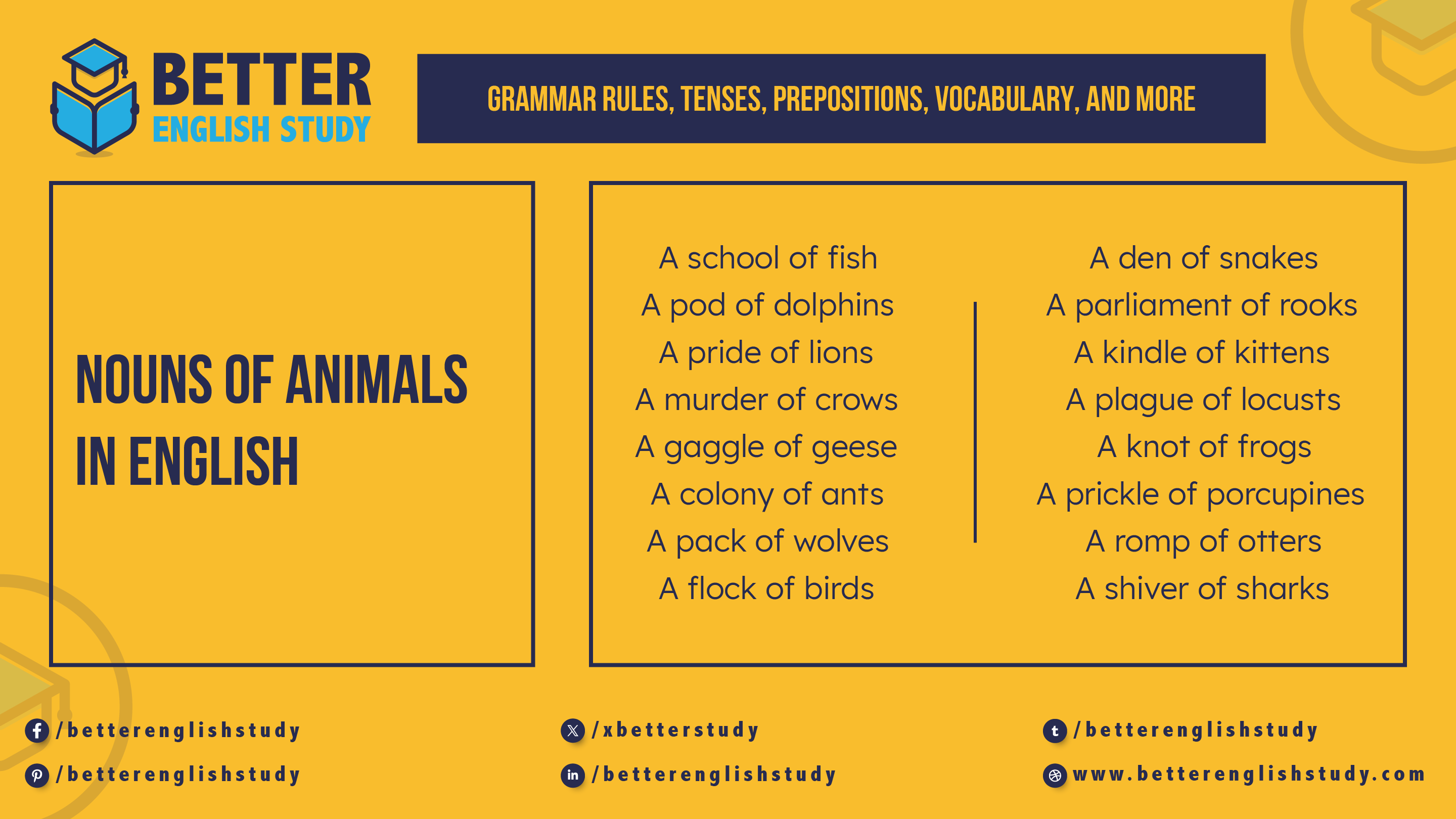
Collective nouns for animals are some of the most colorful and imaginative aspects of the English language. These nouns not only describe groups of animals but also often give a hint about their behavior or characteristics. Whether you’re an animal enthusiast, a writer, or a student, knowing these collective nouns can add flair to your descriptions.
Let’s explore the fascinating world of collective nouns for animals.
Understanding Collective Nouns
Collective nouns are words used to describe a group of individuals, animals, or things. In the animal kingdom, these nouns can be quite creative, often derived from observations of the animals’ behavior or appearance. For example, a “murder of crows” suggests the bird’s ominous presence, while a “parliament of owls” implies wisdom.
List of Collective Nouns for Animals
Here is a list of some common and not-so-common collective nouns used for animal group names.
| A school of fish | A den of snakes |
| A pod of dolphins | A parliament of rooks |
| A pride of lions | A kindle of kittens |
| A murder of crows | A plague of locusts |
| A gaggle of geese | A knot of frogs |
| A colony of ants | A prickle of porcupines |
| A pack of wolves | A romp of otters |
| A flock of birds | A shiver of sharks |
| A herd of elephants | A sleuth of bears |
| A swarm of bees | A sounder of pigs |
| A troop of monkeys | A streak of tigers |
| A litter of puppies | A team of horses (in harness) |
| A parliament of owls | A tower of giraffes |
| A clutch of eggs | A warren of rabbits |
| A bale of turtles | A zeal of zebras |
| A leap of leopards | An ambush of tigers |
| A bloat of hippopotamuses | An array of hedgehogs |
| A cackle of hyenas | An ascension of larks |
| A raft of ducks (on water) | An aurora of polar bears |
| A skulk of foxes | An army of frogs |
| A covey of quail | A band of gorillas |
| A drove of cattle | A bevy of swans |
| A cast of falcons | A coalition of cheetahs |
| A business of ferrets | A drift of swine |
| A crash of rhinoceroses | A muster of peacocks |

Example Sentences with Collective Nouns for Animals
Collective nouns for animals can make your writing more vivid and descriptive. Here are 20 example sentences that incorporate collective nouns for various animals:
- A school of fish swam gracefully through the clear water.
- We spotted a pod of dolphins playing in the waves near the shore.
- The pride of lions rested under the shade of a large tree.
- A murder of crows cawed loudly as they circled overhead.
- A gaggle of geese waddled across the park, honking noisily.
- The picnic was ruined by a swarm of bees that suddenly appeared.
- We watched as a pack of wolves hunted together in the forest.
- A flock of birds flew south for the winter.
- The safari group was thrilled to see a herd of elephants crossing the savannah.
- A troop of monkeys swung from tree to tree in the jungle.
- The farmer found a litter of puppies sleeping in the barn.
- As night fell, a parliament of owls began their haunting calls.
- The zookeeper carefully handled the clutch of eggs in the incubator.
- We saw a bale of turtles sunbathing on the rocks by the river.
- A leap of leopards stealthily moved through the tall grass.
- The tourists were amazed by the size of the bloat of hippopotamuses in the river.
- The eerie laughter of a cackle of hyenas echoed through the night.
- A raft of ducks floated serenely on the lake.
- The skulk of foxes emerged from their den at dusk.
- A covey of quail scattered into the underbrush as we approached.
These sentences illustrate how collective nouns can enhance your descriptions of animal groups, making your language more precise and engaging.
The Importance of Collective Nouns
Using the correct collective noun can enhance your writing by providing more specific and vivid imagery. For instance, saying “a murder of crows” instead of just “a group of crows” immediately conjures a more vivid picture and adds an element of intrigue or menace.
Fun Facts About Collective Nouns for animals
Many collective nouns have fascinating origins rooted in history and folklore. For example:
- A pride of lions: This term reflects the regal and majestic nature of lions.
- A murder of crows: Crows are often associated with dark omens and death, hence the term “murder.”
- A parliament of owls: Owls are symbols of wisdom, and the term “parliament” reflects their stately and wise appearance.
Collective nouns for animals add a rich layer to the English language, making descriptions more precise and colorful. Whether you’re writing a story, giving a presentation, or just engaging in casual conversation, knowing these terms can make your language more engaging and expressive.
So next time you see a group of animals, try using the appropriate collective noun and see how it transforms your description!
